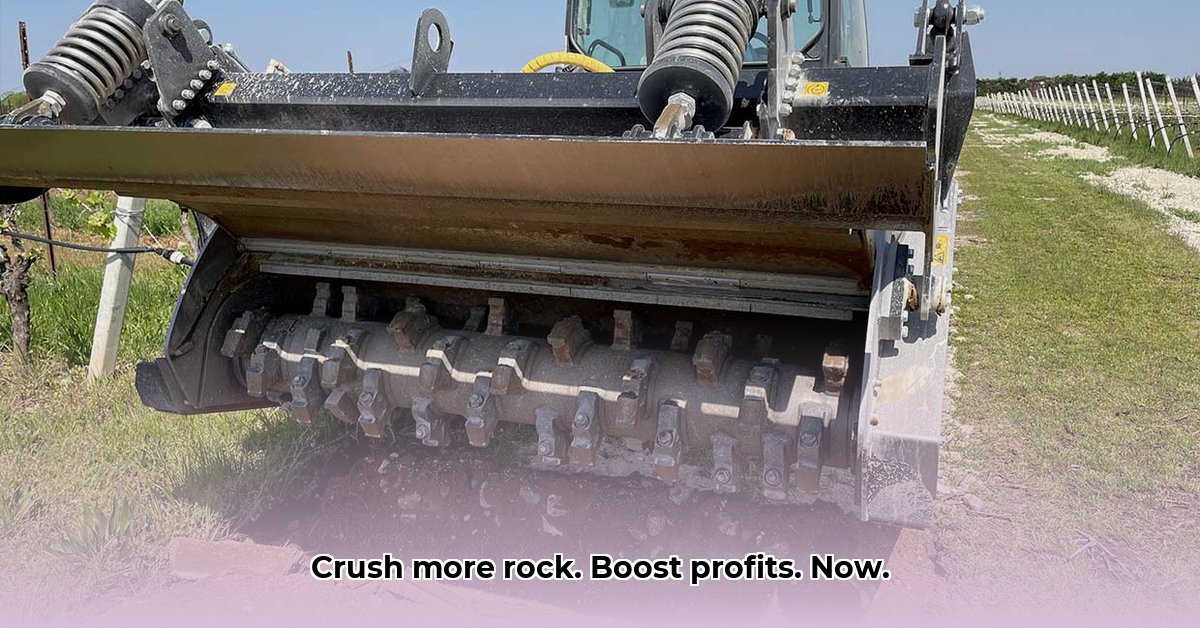
Dealing with rocks on your land can significantly impact productivity and efficiency. But what if you could effortlessly crush those rocks and reclaim valuable time and resources? This guide provides a comprehensive approach to using a tractor rock crusher, from selection and setup to maintenance and troubleshooting. Whether you're a seasoned farmer or a first-time user, we'll equip you with the knowledge to master this powerful tool. For more information on tractor power take-offs, check out this helpful resource on tractor PTO.
Choosing the Right Rock Crusher for Your Tractor
Selecting the appropriate rock crusher is crucial for optimal performance and safety. Several key factors influence this decision. Don't rush this process; taking your time will pay off in the long run.
What size rocks are you crushing? Small pebbles require a different crusher than large boulders. Consider the size and quantity of rocks to determine the necessary crusher capacity.
Check your tractor's specifications. Ensure your tractor has sufficient horsepower and capacity to handle the chosen crusher. Overloading your tractor can lead to serious damage. Consult your tractor's manual to determine the maximum weight and power draw it can safely handle. This is a non-negotiable step. Ignoring this could be disastrous.
Compare features and models. Different models offer varying features, such as hydraulic adjustments for fine control or simpler mechanical adjustments, and PTO(Power Take-Off) driven systems. Thoroughly research different brands and models, reading reviews to inform your decision. Consider factors like weight and maneuverability; a heavier crusher might limit your tractor's agility in tighter spaces.
| Feature | Key Considerations |
|---|---|
| Crusher Size | Match the crusher's capacity to the size and volume of rocks you anticipate crushing. |
| Power Requirements | Verify your tractor's horsepower exceeds the crusher's requirements to avoid overloading. |
| Hydraulic vs. Mechanical | Hydraulic systems offer superior control; mechanical systems are generally simpler and cheaper. |
| PTO Drive | PTO-driven crushers are common and generally reliable; ensure your tractor has a compatible PTO. |
| Weight | Heavier crushers are potentially more powerful, but can reduce tractor maneuverability. |
Getting Started: Safely Operating Your Rock Crusher
Safety is paramount! Always fully read and understand the manufacturer’s manual before operating the machine. This isn't just a suggestion; it's a crucial step to ensure both your safety and the equipment's longevity. Before each use, conduct a thorough visual inspection for any loose bolts, damaged components, or potential hazards.
Step-by-Step Operation:
- Secure Attachment: Carefully attach the crusher to your tractor's three-point hitch, precisely following the manufacturer’s instructions. Improper attachment poses significant safety risks and compromises performance.
- Gradual Start-Up: Begin operation slowly and gently, allowing time to gauge the crusher's power and responsiveness. A gradual start minimizes jerky movements and potential accidents.
- Depth Adjustment: Carefully regulate the depth setting to control how deeply the crusher penetrates the ground. Start conservatively, making adjustments as needed. Excessive depth risks equipment damage; insufficient depth leads to ineffective crushing.
- Continuous Monitoring: Maintain constant vigilance; pay close attention to the crusher’s sounds and vibrations. Unusual noises or vibrations may indicate a problem, requiring immediate cessation of operation and investigation.
- Regular Maintenance: Regular maintenance is vital for optimal performance and longevity. Check oil levels and lubricate moving parts as specified in the maintenance schedule detailed in your operator's manual. This prevents premature wear and tear, leading to prolonged performance.
Maximizing Your Investment: Pros and Cons of Tractor Rock Crushers
Weighing the advantages and disadvantages helps make an informed decision.
Advantages:
- Time Savings: Crushing rocks is significantly faster and more efficient than manual methods, saving considerable time and labor.
- Soil Improvement: Crushing rocks can enhance soil drainage and aeration, fostering healthier plant growth and potentially boosting yields.
- Cost-Effectiveness (Long-Term): While the initial investment is significant, it often proves more cost-effective over time compared to hiring manual labor.
Disadvantages:
- High Initial Cost: Rock crushers represent a substantial upfront expense.
- Maintenance Requirements: Regular maintenance is crucial to prevent breakdowns and prolong lifespan.
- Tractor Compatibility: Ensure your tractor possesses the necessary horsepower to avoid damage.
Key Takeaways for Successful Rock Crushing:
- Thorough research is essential before purchasing a rock crusher. Understanding your requirements, comparing models, and checking tractor compatibility ensures you select the appropriate equipment.
- Safety should always be the top priority. Reading the manual, conducting pre-operation checks, and adhering to safety guidelines are crucial for safe operation.
- Regular maintenance is key to maximizing the lifespan and performance of your rock crusher. Following the maintenance schedule outlined in the manual will keep your equipment running smoothly for years to come.
Remember, efficient and safe rock crushing significantly improves land management and productivity. By understanding these factors and following safe practices, you can effectively master this valuable tool and optimize your operations.